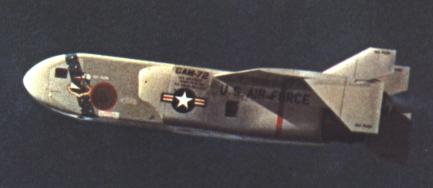|
|
|
McDonald ADM-20 Quail
Missile
|
|
 |
The most successful of the decoy
missiles proved to be the McDonnell Quail -- most successful because
it not only became operational, but it served SAC for more than ten
years. The Quail missile program began on 13 October 1952 when the
Strategic Air Command submitted a requirement to Headquarters USAF for
an air-launched decoy missile. The latter, in turn, directed the Air
Research and Development Command to study the technological
feasibility, costs, and other pertinent aspects of such a proposed
weapon system. The program formally was initiated in April 1955, with
formal requirement (GOR 139) established in January 1956. On 1
February 1956, the Air Material Command notified the McDonnell
Aircraft Company of its selection as prime contractor for the Quail.
Flight tests began in July 1957, with the first glide test in November
1957 and the f first successful powered flight, which lasted 14
minutes and covered 103 miles, in August 1958. The progress of the
tests enabled McDonnell to gain a production contract on 31 December
1958, about the same time the Air Force terminated so many other
projects.
The GAM-72 (ADM-20A) was a tailless
high-wing delta with four vertical fins. McDonnell designed the
missile to operate at 35,000 to 50,000 feet, at Mach .75 to .9, with a
range (depending on altitude) of 357 to 445 nm. While eight could be
carried on the B-52 and four on the B47, the normal loading was,
respectively, four and two.
The Quail simulated the bomber in a
number of ways. First, its operational performance was comparable to
the B-52; and it could be programmed (on the ground) to make at least
two changes in direction and one in speed during its 46- to 55-minute
flight. Second, its slab sides and twin vertical ventral and twin
vertical dorsal few produced a radar image similar to the bomber. In
addition, the GAM-72 carried a 100-pound ECM payload consisting
initially of a responder, later of both chaff and a heat source.
A General Electric J85 powered the
decoy and caused most of the problems on the project, even though the
same engine also powered the Northrop T-38. These problems led to
modification of the engine, one of the major differences between the
original GAM-72 (AGM-20A) and its successor, the GAM-72A (AGM-20B).
The latter used the J85-GE-7, which had eight compressor stages
instead of the seven stages in the J85-GE-3. The GAM-72A weighed
almost 200 pounds more than the GAM-72, but had the same engine power
and less wing area. Hence, it carried less payload a shorter time and
distance at the same speed. The GAM-72A first flew in March 1960.
SAC received its first GAM-72 in on 13
September 1960, when the first production-line Quail missiles were
delivered to the 4135th Strategic Wing, a B-52G unit at Eglin Air
Force Base, Florida. Headquarters SAC declared one Quail-equipped
squadron of the 4135th Strategic Wing operational on 1 February 1961,
and eleven B-52 squadrons were fully equipped and operational by 31
December 1961. The fourteenth and final Quail-equipped B-52 squadron
became operational on 15 April 1962. The McDonnell Aircraft
Corporation delivered the last Quail missile to the Strategic Air
Command on 28 May 1962. SAC had 492 Quails at its peak inventory in
1963. In all, McDonnell produced 616 of the missiles.
But while the Quail served on, there
were major problems. Reliability declined. Improvements in enemy radar
rendered the Quail less effective. In a 1972 test, radar controllers
correctly identified the B-52s 21 out of 23 times. By then, USAF
recognized that the Quail was no longer a credible decoy. In 1971, the
commander of SAC wrote the Air Force Chief of Staff that the Quail was
only slightly better than nothing. The General's candor may have
reflected the fact that the Air Force was already taking action to
provide a more effective decoy.
The Quail remained operational until
1978. Although Strategic Air Command continued to support Quail as an
effective and inexpensive penetration aid, the Air Force elected to
phase out the missile because the lack of spare parts and adequate
test equipment had made the system difficult to maintain. The last
Quail missile came off alert on 30 June 1978 and the Quail was
eliminated from SAC's missile inventory by mid-December.
Specifications
|
|
| Span: |
2 ft. 5 in. (wings folded) -- 5 ft. 5 in. (wings unfolded)
Length: 12 ft. 11 in. |
| Height: |
2 ft. 2 in. (wings folded) -- 3 ft. 4 in. (wings unfolded)
|
| Weight: |
1,198 lbs.
|
| Armament: |
None |
| Engine: |
General Electric
J85-GE-3 of 2,450 lbs. thrust |
| Operating speed:
|
650 mph. |
| Range: |
400 miles
|
| Service Ceiling: |
Over 50,000 ft.
|
|
|
|
